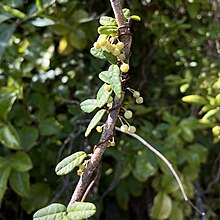
Back المحاكاة عند النباتات Arabic Mimetismo en las plantas Spanish Mimetismo nelle piante Italian 植物における擬態 Japanese ꯄꯥꯝꯕꯤꯗ ꯃꯇꯧ ꯇꯝꯕꯒꯤ ꯆꯠꯅꯕꯤ MNI Mimikry hos växter Swedish 植物拟态 WUU 植物拟态 Chinese

In evolutionary biology, mimicry in plants is where a plant organism evolves to resemble another organism physically or chemically, increasing the mimic's Darwinian fitness. Mimicry in plants has been studied far less than mimicry in animals, with fewer documented cases and peer-reviewed studies. However, it may provide protection against herbivory, or may deceptively encourage mutualists, like pollinators, to provide a service without offering a reward in return.[2]
Types of plant mimicry include Bakerian, where female flowers imitate males of the same species, Müllerian mimicry of the flower or fruit, where a plant mimics a rewarding flower (Dodsonian), luring pollinators by mimicking another species of flower, or fruit where feeders of the other species are attracted to a fake fruit to distribute seeds, Vavilovian, where a weed is unintentionally artificially selected to resemble a crop plant, Pouyannian, in which a flower imitates a female mate for a pollinating insect, Batesian, where a harmless species deter predators by mimicking the characteristics of a harmful species, and leaf mimicry, where a plant resembles a nearby plant to evade the attention of herbivores.
- ^ Cite error: The named reference
Gianoli 2014was invoked but never defined (see the help page). - ^ Pannell, John R.; Farmer, Edward E. (2016-09-12). "Mimicry in plants". Current Biology. 26 (17): R784–R785. doi:10.1016/j.cub.2016.04.005. PMID 27623255.